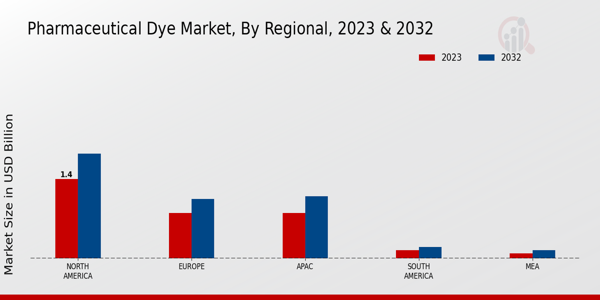Expansion of Emerging Markets
The expansion of emerging markets plays a crucial role in shaping the Global Pharmaceutical Dye Market Industry. Countries in Asia-Pacific and Latin America are witnessing rapid growth in their pharmaceutical sectors, driven by increasing healthcare investments and rising population demands. This expansion creates new opportunities for pharmaceutical dye manufacturers to tap into these markets. As local pharmaceutical companies seek to enhance their product offerings, the demand for high-quality dyes is likely to surge. This trend is expected to contribute to the overall market growth, aligning with the projected increase in global pharmaceutical expenditures.
Advancements in Analytical Techniques
Advancements in analytical techniques significantly influence the Global Pharmaceutical Dye Market Industry. Techniques such as high-performance liquid chromatography and mass spectrometry require specialized dyes for accurate analysis and quality assurance. These innovations enhance the precision of drug testing and formulation processes, thereby driving the demand for pharmaceutical dyes. As the industry evolves, the need for dyes that can withstand rigorous testing conditions becomes increasingly critical. This trend aligns with the projected compound annual growth rate of 3.73% from 2025 to 2035, suggesting a sustained growth in the market driven by technological advancements.
Growing Demand for Biopharmaceuticals
The increasing demand for biopharmaceuticals is a key driver for the Global Pharmaceutical Dye Market Industry. As biopharmaceuticals gain traction due to their efficacy and specificity, the need for high-quality dyes used in their production processes becomes paramount. These dyes are essential for various applications, including drug formulation and quality control. The market is projected to reach 3.48 USD Billion in 2024, reflecting the rising investments in biopharmaceutical research and development. This trend is expected to continue, with the market potentially expanding to 5.21 USD Billion by 2035, indicating a robust growth trajectory.
Rising Focus on Sustainable Practices
The rising focus on sustainable practices within the pharmaceutical sector is emerging as a significant driver for the Global Pharmaceutical Dye Market Industry. Companies are increasingly seeking eco-friendly dyes that minimize environmental impact while maintaining product quality. This shift towards sustainability is not only driven by regulatory pressures but also by consumer preferences for greener products. As a result, manufacturers are investing in the development of biodegradable and non-toxic dyes. This trend could potentially reshape the market dynamics, leading to increased demand for innovative dye solutions that align with sustainability goals.
Regulatory Compliance and Quality Assurance
Regulatory compliance and quality assurance are pivotal in the Global Pharmaceutical Dye Market Industry. Stringent regulations imposed by health authorities necessitate the use of approved dyes in pharmaceutical products. This requirement ensures that the dyes meet safety and efficacy standards, thereby fostering consumer trust. As pharmaceutical companies strive to comply with these regulations, the demand for certified dyes is likely to increase. The market's growth is further supported by the anticipated rise in global pharmaceutical spending, which is expected to enhance the overall market landscape for pharmaceutical dyes.





















Leave a Comment